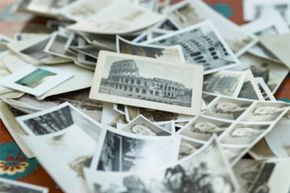Even photos you took last week will someday be really old, so invest in a proper storage system from the start! Your local craft store carries the basic supplies you'll need. Stock up on albums with archival sleeves as well as acid-free photo storage boxes. Before filing and packing away any old photos, toss out paper clips, rubber bands, manila envelopes, staples and anything that has an odor. Wear cotton gloves while handling photographs to avoid long-term fingerprint damage.
Photos with historic significance should be treated extra carefully. In these cases, it's usually best to seek the help of a professionally trained conservator, who can clean, treat and prepare the photos for storage in the most effective manner possible
Often, the environment is just as important as the storage container itself. The ideal storage environment for photographs is a dark location around 68 degrees Fahrenheit with 30 to 40 percent relative humidity, according to the Library of Congress. That said, don't put boxes of photos in your attic or garage, as photos require an environment that isn't overly hot, cold, humid or dry. Fireproof or flood-proof storage boxes are also available for storing valuable photos.
In addition to storing photos themselves, put original transparencies (negatives or slides) and digital copies in a safe place. Before you store old photos, you should consider making digital scans and copying the files onto CDs. Some CDs might not last too long, though, so be sure to pop them in your computer every few years to make sure they're still working. Alternatively, you can load photos on a USB drive.
Above all, be sure to label your photos with the names of the people and places featured, as well as the date. You might remember your Great Aunt Mildred's full name, but your grandchildren will thank you for writing down the specifics. Note the details on the back of the photo using a soft drawing pencil as ink can cause unnecessary damage.


